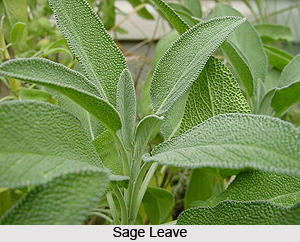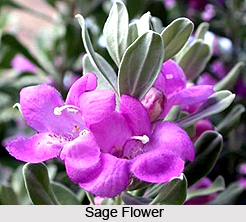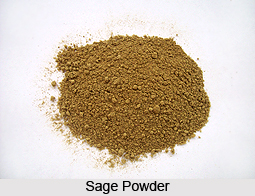 Sage is a hardy, variable sub-shrub, native of Southern Europe, often cultivated as a spice and for medicinal purposes. It is also grown for ornament. Stems are shrubby, white woolly, 15 to 30 cm tall. The flowers of Sage are blue, purple or white simple racemes. The botanical name of sage is Salvia officinalis Linn. It belongs to the Labiatae family. Sage is also known as Salvis and Sefakuss in Hindi language.
Sage is a hardy, variable sub-shrub, native of Southern Europe, often cultivated as a spice and for medicinal purposes. It is also grown for ornament. Stems are shrubby, white woolly, 15 to 30 cm tall. The flowers of Sage are blue, purple or white simple racemes. The botanical name of sage is Salvia officinalis Linn. It belongs to the Labiatae family. Sage is also known as Salvis and Sefakuss in Hindi language.
Young sage plants which have not reached the flowering or seeding stage, posses the finest aroma and contains the large amount of oil. The harvesting is done by hand or by cutting the tops with mower. Sometimes whole plants are cut by small sickles and dried. Sage is dried in the shade to retain the natural colour and flavour. The leaves and small tops are tied into small bundles or spread on screens and dried in a well-ventilated warm room away from sunlight. If the leaves are dusty and gritty, they are washed in cold water before drying. The dried bunches can be sold without further treatment or the leaves may be pulverized for the packeted herb trade.
Composition of Sage
Sage contains:
•Moisture:5.7%
•Protein:10.2%
•Fiber:16.0%
•Carbohydrates:46.3%
•Total ash:7.7%
•Calcium:1.8%
•Phosphorus:0.09%
•Iron:0.03%
•Sodium:0.01%
•Potassium:1.0%
•Vitamin A:2395 I.U./100 gram
•Vitamin B1:0.75 mg/100 gram
•Vitamin B2:0.34 mg/100 gram
•Vitamin C:39.8 mg/100 gram
•Niacin:5.7 mg/100 gram.
•Calorific value: 415-calories/100 gram
 Apart from above and essential oil, the leaves also contain 3% tannin, fumeric acid, malic acid and ursolic acid, a bitter principle, picrosalvin, saponin, pentoses, a wax and potassium nitrate.
Apart from above and essential oil, the leaves also contain 3% tannin, fumeric acid, malic acid and ursolic acid, a bitter principle, picrosalvin, saponin, pentoses, a wax and potassium nitrate.
On steam distillation, dry sage leaves yield an essential oil, 1.3 to 2.6 % on the weight of dry leaves. The constituent reported to be present in the oil are alpha-pinene, cineole, linalyl acetate, thujone (44 to 45%), borneol, bornyl acetate, farnesol, and camphor. The quality of sage oil is determined on the basis of its thujone content; the higher the thujone content the better the oil. Other constituents also vary considerably depending on the country where it is grown and other factors. The quality of oil of the sage leaves of Indian origin is inferior.
 Uses of Sage
Uses of Sage
Sage is the most popular spice for use in culinary preparations in the west. It is used in pork sausage and baked loaf. It is used for flavouring meat and fish dishes and in making poultry stuffing. It has been extensively employed in the food industry as a standard spice in making stuffing for fowl, meats and sausage. Dried and powdered leaves are mixed with cooked vegetables and sprinkled on cheese dishes, cooked meats and other similar preparations. Fresh sage leaves are used in salads and sandwiches. The young leaves are pickled and used for making tea like beverage.
Sage has a lot of medicinal virtues. It is used as mild tonic, astringent and carminative. Extracts of the leaves are reported to be antipyretic. Sage has been prescribed to cure female disorders since ancient times. Dried leaves are used as a fumitory. Leaves rubbed on teeth function as a good dentifrice. Sage oil finds use in perfumes as a deodorant, in insecticidal preparations and as carminative. Sage and sage oil exhibit anti-oxidant properties. Sage is also recommended as a hair rinse for dandruff, oily hair and the infections of the scalp. Sage oil contains alpha and beta thujone, camphor and other constituents well known as gurgle and sore throat and inflammation of the mouth and gums. The seeds contain 18% of protein and yield a drying oil, which is used as a bonding agent in the production of oil paints. The oil cake can be used for manufacture of industrial adhesives.
As spice or for any other purpose it was not traditionally popular in India. But due to improved communication and globalization, as western foods gaining popularity in urban India, demand for this spice is also increasing. Presently, however, bulk of the spice and the oil is being imported both for above purposes as well as for its industrial use.




















